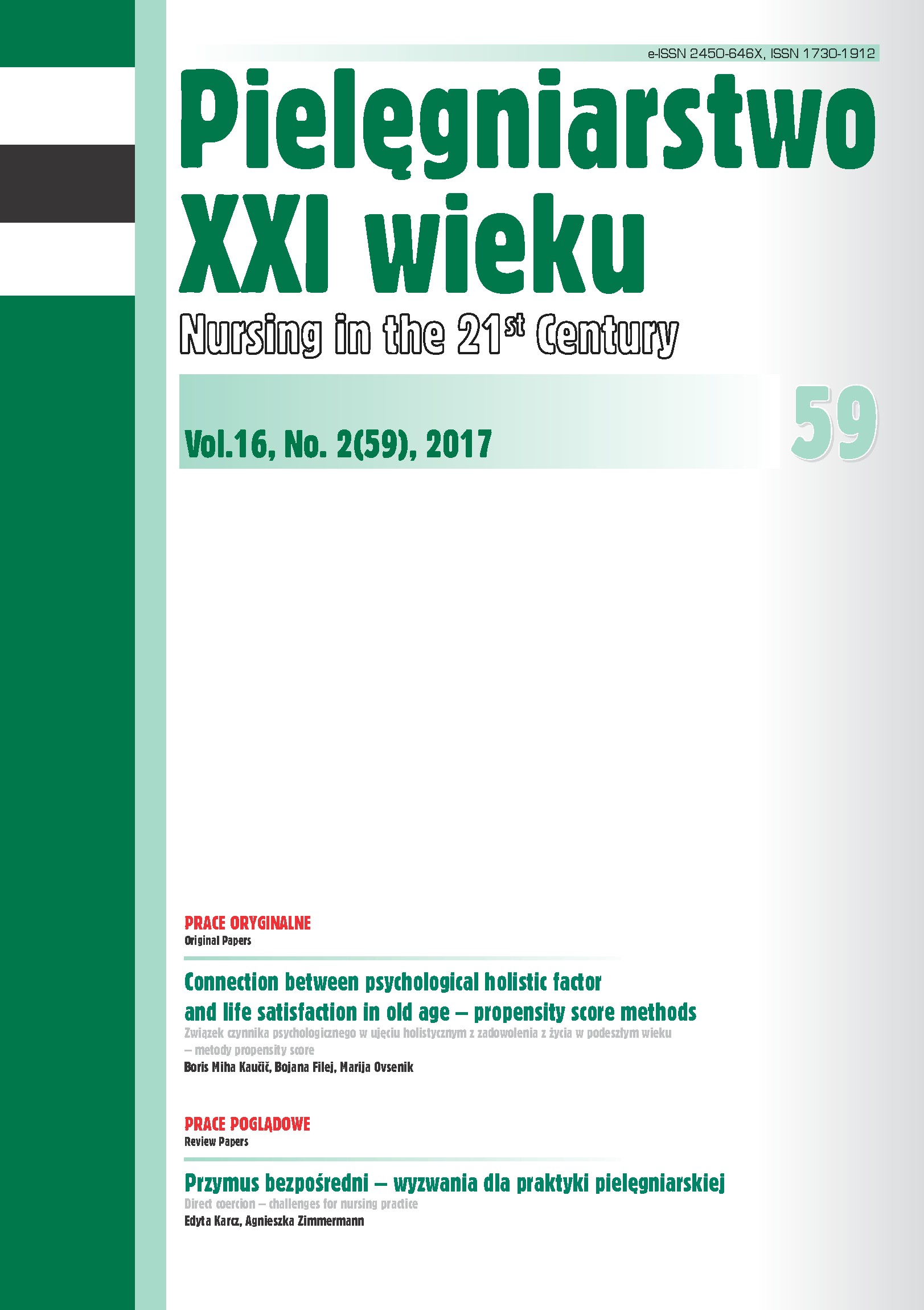Kompetencje zdrowotne i zdrowy tryb życia wśród studentów pielęgniarstwa
DOI:
https://doi.org/10.1515/pielxxiw-2017-0017Słowa kluczowe:
opieka zdrowotna, zachowania prozdrowotne, kompetencje zdrowotneAbstrakt
KOMPETENCJE ZDROWOTNE I ZDROWY TRYB ŻYCIA WŚRÓD STUDENTÓW PIELĘGNIARSTWA
Wprowadzenie. Studenci pielęgniarstwa stanowią istotną populację osób do zgłębiania wiedzy dotyczącej kompetencji zdrowotnych oraz zachowań prozdrowotnych. Z jednej strony jest to grupa młodych dorosłych rozpoczynających samodzielną troskę o własne zdrowie, a z drugiej, uczą się oni by być profesjonalistami, którzy będą przekazywać wsparcie i wiedzę ludziom poprzez zmianę ich stylu życia dążąc do zachowania ich zdrowia lub walki z chorobą. W związku z tym, niniejsze badanie ukierunkowane jest na zgłębianie tematyki kompetencji zdrowotnych oraz zachowań prozdrowotnych wśród studentów pielęgniarstwa.
Materiał i metoda. Badaniem kompetencji zdrowotnych oraz zachowań prozdrowotnych objęto grupę 337 studentów programów związanych z opieką zdrowotną w Słowenii. Wykorzystano dwa narzędzia badawcze do zgłębienia kompetencji zdrowotnych studentów (Kwestionariusz Oceny Kompetencji Zdrowotnych i Skróconą ocenę kompetencji i opieki zdrowotnej – Newest Vital Sign) oraz skalę mierzącą zachowania prozdrowotne.
Wyniki. Analiza czynnikowa wyodrębniła trzy wymiary kompetencji zdrowotnych: rozumienie zdrowia lub choroby, rozumienie instrukcji otrzymywanych od służby zdrowia i orientacja w zakresie systemu zdrowia. Zmienne odnoszące się do kompetencji zdrowotnych i zachowań prozdrowotnych są ściśle powiązane.
Dyskusja i wnioski. Edukacja studentów pielęgniarstwa powinna kłaść nacisk na tematy kompetencji zdrowotnych oraz ich własnej ochrony zdrowia. Powinna także wspierać i zachęcać studentów do prowadzenia zdrowego trybu życia, jako, że powinni oni stanowić przykład tego co wpajają pacjentom.
Bibliografia
1. Marks R. Health Literacy and School-Based Health Education. New York: York College, The City University of New York and Teachers College, Columbia University; 2012.
2. Lee S-YD, Arozullah AM, Cho YI. Health literacy, social support, and health: a research agenda. Soc Sci Med. 2004; 58(7): 1309-1321.
3. Speros C. Health literacy: concept analysis. J Adv Nurs. 2005; 50(6): 633-640.
4. Baker DW. The meaning and the measure of health literacy. J Gen Intern Med. 2006; 21(8): 878-883.
5. Paasche-Orlow MK, Wolf MS. The causal pathways linking health literacy to health outcomes. Am J Health Behav. 2007; 31(1): S19-26.
6. Van Servellen G. Communication skills for the health care professional; concepts, practice and evidence, 2nd ed. Jones and Barlett, Sudbury (Ma.). 2009, p. 203.
7. Manganello JA. Health literacy and adolescents: a framework and agenda for future research. Health Education Research. 2008; 23(5): 840-847.
8. Ghaddar SF, Valerio MA, Garcia CM, Hansen L. Adolescent Health Literacy: The Importance of Credible Sources for Online Health Information. J Sch Health. 2012; 82(1): 28–36.
9. Zarcadoolas C, Pleasant A, Greer DS. Understanding health literacy: an expanded model. Health Promot Int. 2005; 20(2): 195-203.
10. Sorensen K, Van den Broucke S, Fullam J, et al. Health literacy and public health: a systematic review and integration of definitions and models. Am J Trop Med Publ Health. 2012; 12(80): 6-13.
11. Nutbeam D. Health promotion glossary. Health Promot Int. 1998; 13(4): 349-364.
12. Kanj M, Mitic W. Health Literacy and Health Promotion. Nairobi, Kenya: World Health Organization. 2009. Available at: http://www.who.int/healthpromotion/conferences /7gchp/Track 1_Inner.pdf.
13. Nutbeam D. Defining and measuring health literacy: what can we learn from literacy studies?. Int J Publ Health. 2009; 54 (5): 303-305.
14. Liechty J. Health literacy: critical opportunities for social work leadership in health care and research. Health Soc Work. 2011; 36(2): 99-107.
15. Kamin T. Zdravje na barikadah. Dileme promocije zdravja. Ljubljana: Univerza v Ljubljani. Fakulteta za družbene vede. 2006.
16. Long AF, Gambling T. Enhancing health literacy and behavioural change within a tele-care education and support intervention for people with type 2 diabetes. Blackwell Publishing Ltd Health Expectations. 2011;15(3): 267–282.
17. Deeks A, Lombard C, Michelmore J, Teede H. The effects of gender and age on health related behaviors. BMC Public Health. 2009; 9(213): 1-8. doi:10.1186/1471-2458-9-213.
18. Grappasonni I, Petrelli F, Klusoňova H, Kračmarova L. Level of understanding of medical terms among italian students. Ceska Slov Farm. 2016; 65(6): 216-220.
19. Shu-Ching Y, Yi-Fang L, Chia-Hsun C. The Associations Among Individual Factors, eHealth Literacy, and Health-Promoting Lifestyles Among College Students. J Med Internet Res. 2017;19(1): e15. DOI: 10.2196/jmir.5964.
20. Chew LD, Bradley KA, Boyko EJ. Brief questions to identify patients with inadequate health literacy. Family Medicine. 2007; 36(8): 588-594.
21. Štemberger Kolnik T, Babnik K. Development of the health literacy instrument for Slovenian population : results of the pilot study. V: Železnik D, (ur.), Kaučič BM, (ur.), Železnik U. (ur.). Innovation in step with the time - best practice examples: proceedings of lectures with peer rewiev. Slovenj Gradec: University College of Health Sciences; 2012, p. 248-255.
22. Sarafino EP. Health Psychology. Biopsychosocial Interactions. Fifth.ed. Hoboken (NJ): J. Wiley & Sons, cop; 2006, p. 140.
23. Weiss BD, Mays MZ, Martz W, et al. Quick assessment of literacy in primary care: the newest vital sign. Ann Fam Med. 2005; 3(6): 514-522.
24. Zarcadoolas C, Pleasant FA, Greers D. Advancing Health Literacy. A frame work for Understanding and Action. San Francisco: John Wiley&Sons; 2006, p. 1-6.
Opublikowane
Numer
Dział
Licencja
Prawa autorskie (c) 2017 Autorzy

Praca jest udostępniana na licencji Creative Commons Attribution-NonCommercial-NoDerivatives 3.0 Unported License.




